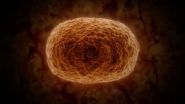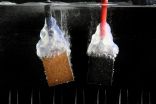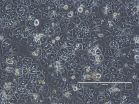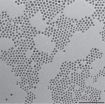(Press-News.org) VIDEO:
Science published on Sept. 25, 2014 the latest developments in Michael Grätzel's laboratory at EPFL in the field of hydrogen production from water. By combining a pair of perovskite solar...
Click here for more information.
The race is on to optimize solar energy's performance. More efficient silicon photovoltaic panels, dye-sensitized solar cells, concentrated cells and thermodynamic solar plants all pursue the same goal: to produce a maximum amount of electrons from sunlight. Those electrons can then be converted into electricity to turn on lights and power your refrigerator.
At the Laboratory of Photonics and Interfaces at EPFL, led by Michael Grätzel, where scientists invented dye solar cells that mimic photosynthesis in plants, they have also developed methods for generating fuels such as hydrogen through solar water splitting.
To do this, they either use photoelectrochemical cells that directly split water into hydrogen and oxygen when exposed to sunlight, or they combine electricity-generating cells with an electrolyzer that separates the water molecules.
By using the latter technique, Grätzel's post-doctoral student Jingshan Luo and his colleagues were able to obtain a performance so spectacular that their achievement is being published today in the journal Science. Their device converts into hydrogen 12.3 percent of the energy diffused by the sun on perovskite absorbers – a compound that can be obtained in the laboratory from common materials, such as those used in conventional car batteries, eliminating the need for rare-earth metals in the production of usable hydrogen fuel.
Bottled sun
This high efficiency provides stiff competition for other techniques used to convert solar energy. But this method has several advantages over others:
"Both the perovskite used in the cells and the nickel and iron catalysts making up the electrodes require resources that are abundant on Earth and that are also cheap," explained Jingshan Luo. "However, our electrodes work just as well as the expensive platinum-based models customarily used."
On the other hand, the conversion of solar energy into hydrogen makes its storage possible, which addresses one of the biggest disadvantages faced by renewable electricity—the requirement to use it at the time it is produced.
"Once you have hydrogen, you store it in a bottle and you can do with it whatever you want to, whenever you want it," said Michael Grätzel. Such a gas can indeed be burned – in a boiler or engine – releasing only water vapor. It can also pass into a fuel cell to generate electricity on demand. And the 12.3% conversion efficiency achieved at EPFL "will soon get even higher," promised Grätzel.
More powerful cells
These high efficiency values are based on a characteristic of perovskite cells: their ability to generate an open circuit voltage greater than 1 V (silicon cells stop at 0.7 V, for comparison).
"A voltage of 1.7 V or more is required for water electrolysis to occur and to obtain exploitable gases," explained Jingshan Luo. To get these numbers, three or more silicon cells are needed, whereas just two perovskite cells are enough. As a result, there is more efficiency with respect to the surface of the light absorbers required. "This is the first time we have been able to get hydrogen through electrolysis with only two cells!" Luo adds.
The profusion of tiny bubbles escaping from the electrodes as soon as the solar cells are exposed to light say it better than words ever could: the combination of sun and water paves a promising and effervescent way for developing the energy of the future.
INFORMATION: END
Harvesting hydrogen fuel from the Sun using Earth-abundant materials
Combination of perovskite solar cells and nickel-iron catalysts resulted in an astounding 12.3 solar to hydrogen efficiency
2014-09-25
ELSE PRESS RELEASES FROM THIS DATE:
Innovative Stone Age tools were not African invention, say researchers
2014-09-25
A new discovery of thousands of Stone Age tools has provided a major insight into human innovation 325,000 years ago and how early technological developments spread across the world, according to research published in the journal Science.
Researchers from Royal Holloway, University of London, together with an international team from across the United States and Europe, have found evidence which challenges the belief that a type of technology known as Levallois – where the flakes and blades of stones were used to make useful products such as hunting weapons – was invented ...
New discovery could pave the way for spin-based computing
2014-09-25
PITTSBURGH—Electricity and magnetism rule our digital world. Semiconductors process electrical information, while magnetic materials enable long-term data storage. A University of Pittsburgh research team has discovered a way to fuse these two distinct properties in a single material, paving the way for new ultrahigh density storage and computing architectures.
While phones and laptops rely on electricity to process and temporarily store information, long-term data storage is still largely achieved via magnetism. Discs coated with magnetic material are locally oriented ...
Longstanding bottleneck in crystal structure prediction solved
2014-09-25
Two years after its release, the HIV-1 drug Ritonavir was pulled from the market. Scientists discovered that the drug had crystallized into a slightly different form—called a polymorph—that was less soluble and made it ineffective as a treatment.
The various patterns that atoms of a solid material can adopt, called crystal structures, can have a huge impact on its properties. Being able to accurately predict the most stable crystal structure for a material has been a longstanding challenge for scientists.
"The holy grail of this particular problem is to say, I've written ...
Genetic 'instruction set' for antibodies knocks down hepatitis C in mice
2014-09-25
A triple-punch of antibodies both prevented hepatitis C infection and wiped out the disease after it had established itself in laboratory mice, according to a study led by Princeton University researchers. Instead of delivering the three antibodies directly, the researchers administered a genetic "instruction set" that, once in a cell, developed into antibodies that target the portions of the virus that do not mutate.
Mice treated with the antibody genetic code resisted becoming infected with hepatitis C when they were exposed to the virus, the researchers reported in ...
On the road to artificial photosynthesis
2014-09-25
The excessive atmospheric carbon dioxide that is driving global climate change could be harnessed into a renewable energy technology that would be a win for both the environment and the economy. That is the lure of artificial photosynthesis in which the electrochemical reduction of carbon dioxide is used to produce clean, green and sustainable fuels. However, finding a catalyst for reducing carbon dioxide that is highly selective and efficient has proven to be a huge scientific challenge. Meeting this challenge in the future should be easier thanks to new research results ...
Study: Widespread vitamin D deficiency in thyroidectomy patients
2014-09-25
DETROIT – A new study from researchers at Henry Ford Hospital in Detroit finds widespread vitamin D deficiency among patients who undergo a thyroidectomy, potentially putting them at greater risk for developing dangerously low blood calcium levels after surgery.
Among the patients in the Henry Ford study, 40 percent had low vitamin D levels prior to surgery. Those more likely to be vitamin D deficient are individuals older than age 50, African Americans, Hispanics and patients undergoing surgery for hyperthyroidism.
"The issue of vitamin D deficiency in patients who ...
How to make stronger, 'greener' cement
2014-09-25
CAMBRIDGE, Mass--Concrete is the world's most-used construction material, and a leading contributor to global warming, producing as much as one-tenth of industry-generated greenhouse-gas emissions. Now a new study suggests a way in which those emissions could be reduced by more than half — and the result would be a stronger, more durable material.
The findings come from the most detailed molecular analysis yet of the complex structure of concrete, which is a mixture of sand, gravel, water, and cement. Cement is made by cooking calcium-rich material, usually limestone, ...
BUSM researchers find NAS treatment needs standardization
2014-09-25
(Boston) – When it comes to treating infants with neonatal abstinence syndrome (NAS), researchers from Boston University School of Medicine (BUSM) believe the care for these infants should be consistent and objective, with standardized assessment tools and evidence to back up pharmacologic and nonpharmacologic treatment choices.
The review paper, which is published online in Addiction Science & Clinical Practice, highlights the need for more research in this field to optimize care for both infants and their mothers.
NAS is a collection of signs and symptoms infants ...
Fecal microbiota transplantation recommended for treatment of C. difficile
2014-09-25
(Vienna, October 26, 2014) The transplantation of faecal microbiota from a healthy donor has been shown in recent clinical studies to be a safe and highly effective treatment for recurrent Clostridium difficile (C. difficile) infection and is now recommended in European treatment guidelines.1,2 Faecal microbiota transplantation (FMT) has emerged as a revolutionary, potentially life-saving treatment for this common, difficult-to-treat infection, and is showing promise in the management of other microbiota-related conditions.3,4
Presenting at the 22nd United European Gastroenterology ...
In the face of uncertainty, the brain chooses randomness as the best strategy
2014-09-25
AUDIO:
Editor Karen Carniol interviews Dr. Alla Karpova on her latest Cell paper.
Click here for more information.
Past experience is usually a reliable guide for making decisions, but in unpredictable and challenging situations, it might make more sense to take risks. A study published by Cell Press September 25th in the journal Cell shows that, in competitive situations, rats abandon their normal tactic of using past experience to make decisions and instead make random choices ...
LAST 30 PRESS RELEASES:
Decoupling the HOR enhancement on PtRu: Dynamically matching interfacial water to reaction coordinates
Sulfur isn’t poisonous when it synergistically acts with phosphine in olefins hydroformylation
URI researchers uncover molecular mechanisms behind speciation in corals
Chitin based carbon aerogel offers a cleaner way to store thermal energy
Tracing hidden sources of nitrate pollution in rapidly changing rural urban landscapes
Viruses on plastic pollution may quietly accelerate the spread of antibiotic resistance
Three UH Rainbow Babies & Children’s faculty elected to prestigious American Pediatric Society
Tunnel resilience models unveiled to aid post-earthquake recovery
Satellite communication systems: the future of 5G/6G connectivity
Space computing power networks: a new frontier for satellite technologies
Experiments advance potential of protein that makes hydrogen sulfide as a therapeutic target for Alzheimer’s disease
Examining private equity’s role in fertility care
Current Molecular Pharmacology achieves a landmark: real-time CiteScore advances to 7.2
Skeletal muscle epigenetic clocks developed using postmortem tissue from an Asian population
Estimating unemployment rates with social media data
Climate policies can backfire by eroding “green” values, study finds
Too much screen time too soon? A*STAR study links infant screen exposure to brain changes and teen anxiety
Global psychiatry mourns Professor Dan Stein, visionary who transformed mental health science across Africa and beyond
KIST develops eco-friendly palladium recovery technology to safeguard resource security
Statins significantly reduce mortality risk for adults with diabetes, regardless of cardiovascular risk
Brain immune cells may drive more damage in females than males with Alzheimer’s
Evidence-based recommendations empower clinicians to manage epilepsy in pregnancy
Fungus turns bark beetles’ defenses against them
There are new antivirals being tested for herpesviruses. Scientists now know how they work
CDI scientist, colleagues author review of global burden of fungus Candida auris
How does stroke influence speech comprehension?
B cells transiently unlock their plasticity, risking lymphoma development
Advanced AI dodel predicts spoken language outcomes in deaf children after cochlear implants
Multimodal imaging-based cerebral blood flow prediction model development in simulated microgravity
Accelerated streaming subgraph matching framework is faster, more robust, and scalable
[Press-News.org] Harvesting hydrogen fuel from the Sun using Earth-abundant materialsCombination of perovskite solar cells and nickel-iron catalysts resulted in an astounding 12.3 solar to hydrogen efficiency






